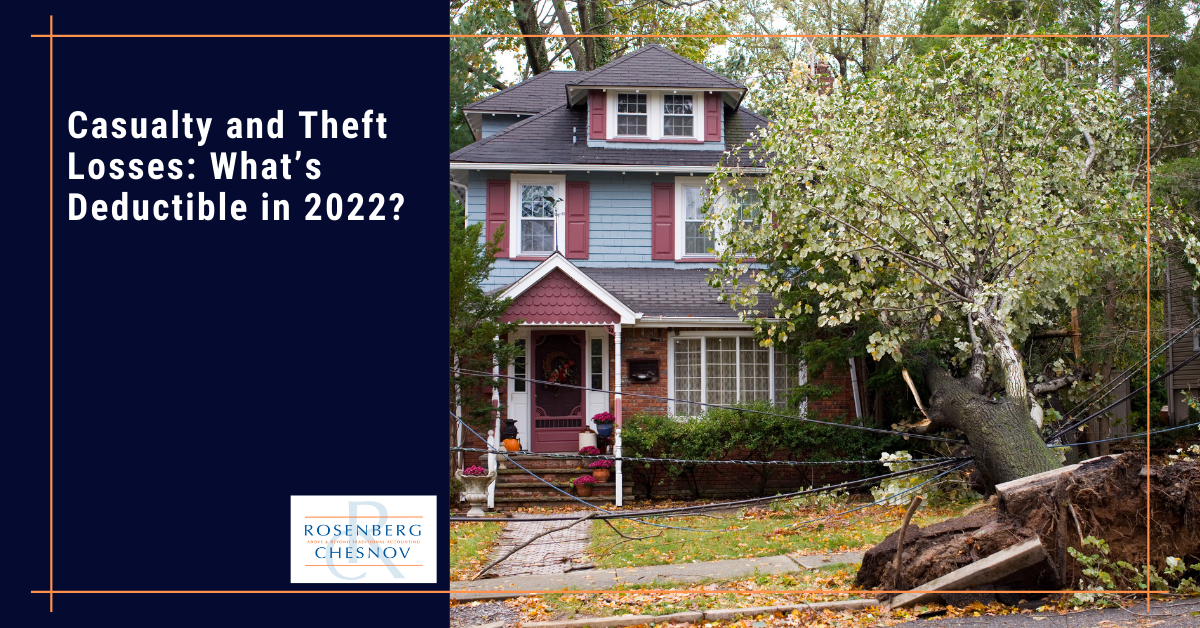

Maximize Your Green Business Tax Savings
Category: Business
Nobody wants to think about the potential destruction of their personal property due to a disaster or loss due to theft.
It’s an unpleasant thought. Nevertheless, tornadoes, earthquakes, fires, and other natural disasters or unforeseen events, as well as car theft and burglaries of personal residences, are the cause of billions upon billions of dollars in losses annually, affecting taxpayers and insurance companies.
It’s essential to account for the possibility of disastrous circumstances to limit the financial toll, recover, and get back on your feet. In this case, that includes understanding personal casualty and theft losses.
However, casualty loss rules are complicated, so there are some things you should know beforehand should the worst happen. Of course, we sincerely hope that you will never need this information. But as the Scout motto goes: Be prepared.
To learn more about what personal casualty or theft losses may be deductible on your tax returns, how to calculate your loss, and when to deduct such losses, continue reading below.


Casualty and theft losses are deductible losses arising from the destruction or loss of a taxpayer’s personal property due to a sudden or unforeseen event.
Simply put, when property gets damaged, destroyed, or stolen, you have to pay to fix or replace it. If the damage results from a sudden event beyond your control, you may be able to deduct the cost of the loss from the taxes you owe.
There are some limitations to the deductibility of such losses, though.
For example, you may not deduct casualty and theft losses covered by insurance unless you file a timely claim for reimbursement, and you reduce the loss by the amount of any reimbursement or expected reimbursement.
Additionally, a personal casualty or theft loss relating to your home, household items, or vehicles is generally deductible (again, subject to limitations) on your federal income tax return only if such loss results from a federally-declared disaster. This means the President of the United States has determined the disaster warrants assistance from the federal government.
This restriction is relatively new, created by a provision of the 2017 Tax Cuts and Jobs Act (TCJA).
It is worth noting that some states, such as New York, decoupled from specific changes enacted by the TCJA for 2018 and after. That means that some taxpayers may still be able to deduct certain losses at the state level in some states.
For areas that the federal government has determined to be federally-declared disaster areas, go to www.fema.gov/disasters.
Although “casualty” and “theft” are both deductible as losses, the IRS does not define them the same way. A casualty occurs when your property suffers damage from a disaster, whereas a theft occurs when someone steals from your property.
If the damage or destruction is the result of your own action, whether willful or accidental, you cannot deduct a loss. For example, damage caused by accidental breakage under normal conditions, a fire you set or paid someone else to set, or damage caused by a family pet are all non-deductible losses.
In fact, as mentioned above, IRS Publication 547 establishes that casualty and theft losses “are deductible only to the extent they’re attributable to a federally declared disaster.”
Some examples include:
Although the above list includes human activities, like terrorist attacks and vandalism, it is important to clarify that, in accordance with the TCJA, such events are only covered if they occur during a federally-declared emergency.
Furthermore, it is also worth noting that only the property owner is eligible to take this deduction. For example, if a flood damages your rental unit, only your landlord, not you, can claim the deduction. (You may be eligible for a rent payment deduction.)
Some examples of a theft loss, or loss due to the illegal taking and removal of money or property with criminal intent, include:
You can claim theft losses using Form 4684.
To claim your casualty and theft losses as an itemized deduction, you’ll need to report them as miscellaneous itemized deductions on Form 4684 (carried over to the Schedule A and 1040 forms). Again, remember that you can only do this if a federally-declared disaster caused your casualty claim.
If you cannot itemize your deductions, and if your casualty losses were not the result of a federally-declared disaster, you will not be able to claim them.
You can determine the deduction for a casualty or theft loss by first calculating the loss with the following steps:
When it comes to business and income-producing property. the decrease in FMV is not considered in calculating the loss for property that is stolen or completely destroyed
Some loss limitations may apply. For example, you will need to reduce each casualty or theft loss event by $100. If multiple pieces of property are damaged in a single event, a single $100 reduction applies.
Finally, a 10% AGI limit may apply. This will require you to reduce the total of all casualty or theft losses by 10% of your AGI or adjusted gross income.
Casualty losses are deductible in the year you sustain the loss, which is generally the year the casualty occurred, or you discovered the theft. However, you may instead be able to deduct losses in the tax year you reasonably determine the reimbursement amount (if any) or the year in which you will receive no additional reimbursement, if that year occurs later than the year you sustained the loss.
Alternatively, you may elect to deduct a casualty loss from a federally-declared disaster in the tax year immediately preceding the disaster year. If you choose to do so, you must make the election within six months after the regular due date (without extensions) for filing the original return for the disaster year.
Finally, if your loss deduction exceeds your income, you may have a Net Operating Loss (NOL). You don’t have to be in business to have an NOL from a casualty. However, if you are facing a business Net Operating Loss, you may wish to consult our recent blog post, which dug deeper into this subject.
Nobody wants to deal with a casualty or theft loss, but unfortunately, it can happen to anyone. Should you face disastrous circumstances, we hope this post will help expedite your recovery.
If you are a client and would like to book a consultation, call us at +1 (212) 382-3939 or contact us here to set up a time.
If you aren’t a client, why not? We can take care of your accounting, bookkeeping, tax, and CFO needs so that you don’t have to worry about any of them. Interested? Contact us here to set up a no-obligation consultation.
Interested in receiving updates in your mailbox? Check out our newsletter, full of information you can use. It comes out once every two weeks, and you can register for it below.
Send us a message and we will contact you as soon as possible.
Jeff Coyle, CPA, Partner of Rosenberg Chesnov, has been with the firm since 2015. He joined the firm after 20 years of business and accounting experience where he learned the value of accurate reporting, using financial information as a basis for good business decisions and the importance of accounting for management.
He is a diligent financial professional, able to manage the details and turn them into relevant business leading information. He has a strong financial background in construction, technology, consulting services and risk management. He also knows what it takes to create organizations having built teams, grown companies and designed processes for financial analysis and reporting.
His business experience includes:
Creating and preparing financial reporting, budgeting and forecasting.
Planning and preparation of GAAP and other basis financial statements.
Providing insight on financial results and providing advice based on those results.
Jeff also has a long history of helping individuals manage their taxes and plan their finances including:
Income tax planning and strategy.
Filing quarterly and annual taxes.
Audit support.
General financial and planning advice.
Prior to joining the firm in 2015, Jeff was in the private sector where he held senior financial and management positions including Controller and Chief Financial Officer. He has experience across industries, including construction, technology and professional services which gives him a deep understanding of business.
Jeff graduated from Montclair State University, he is a CPA and member of the American Institute of Certified Public Accountants, New York State Society of Certified Public Accountants and New Jersey State Society of Public Accountants.
Jody H. Chesnov, CPA, Managing Partner of Rosenberg Chesnov, has been with the firm since 2004. After a career of public accounting and general management, Jody knows the value of good financials. Clarity, decision making, and strategy all start with the facts – Jody has been revealing the facts and turning them into good business results for more than three decades.
He takes a pragmatic approach to accounting, finance and business. His work has supported many companies on their path to growth, including helping them find investors, manage scaling and overcome hurdles. His experience and passion for business reach beyond accounting and he helps businesses focus on what the numbers mean organizationally, operationally and financially.
He has a particular expertise in early-stage growth companies. His strengths lie in cutting through the noise to come up with useful, out of the box, solutions that support clients in building their businesses and realizing their larger visions.
Prior to joining the firm in 2004, Jody was in the private sector where he held senior financial and management positions including General Manager, Chief Financial Officer and Controller. He has experience across industries, which gives him a deep understanding of business.
Jody graduated with a BBA in Accounting from Baruch College, he is a CPA and member of the American Institute of Certified Public Accountants and New York State Society of Certified Public Accountants.
In addition to delivering above and beyond accounting results, Jody is a member of the NYSCPA’s Emerging Tech Entrepreneurial Committee (ETEC), Private Equity and Venture Capital Committee and Family Office Committee.
He is an angel investor through the Westchester Angels, and has served as an advisor for many startup companies and as a mentor through the Founders Institute.